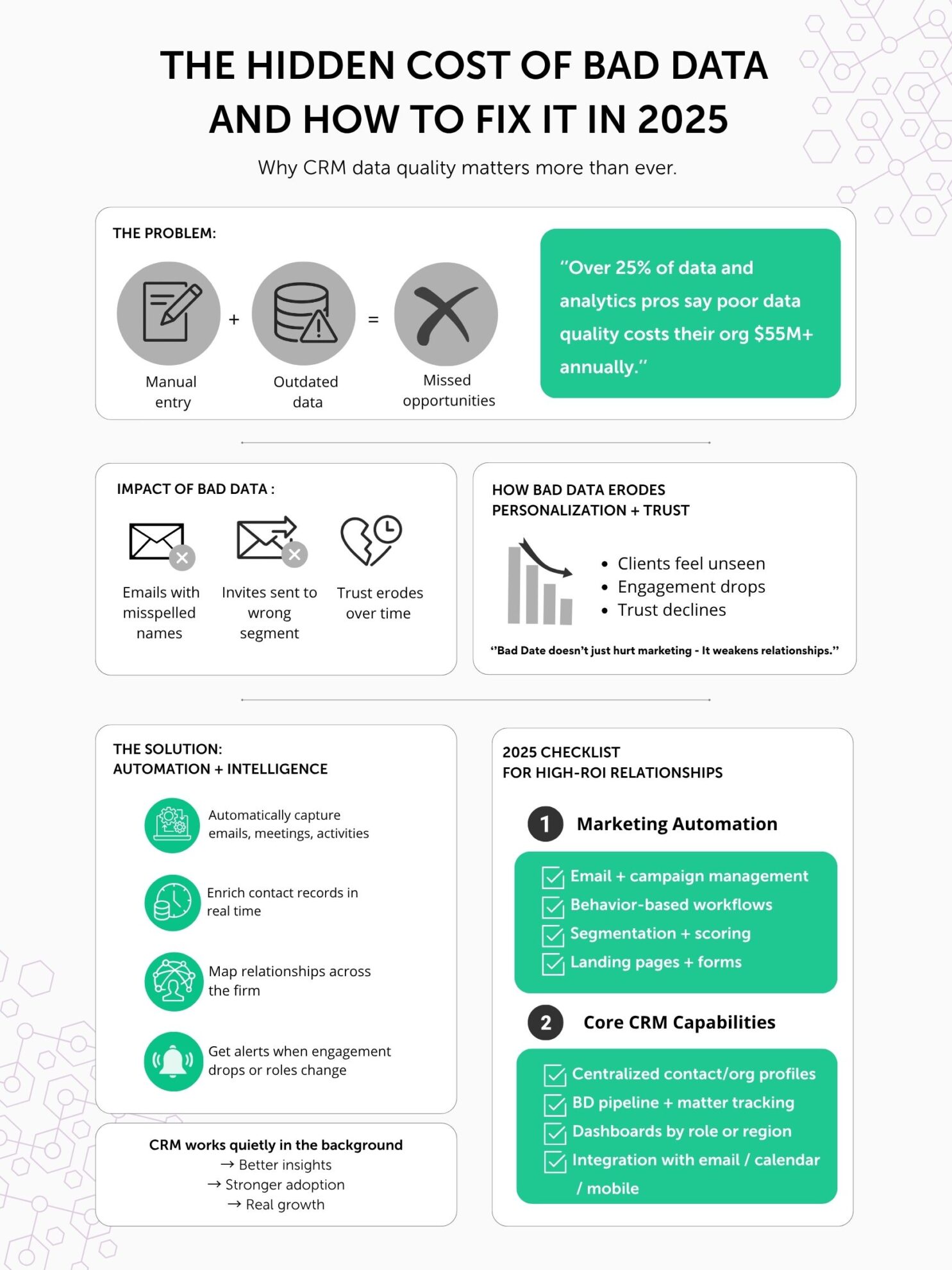Business development and marketing teams, automate repetitive tasks, and deliver more personalized, effective outreach.
Yet for many businesses, the reality falls short. Campaigns underperform. Teams still wrestle with manual data entry. And the “single source of truth” you were promised never materializes.
Why?
Because even the most advanced systems can’t succeed if the underlying data is incomplete, inaccurate, or fragmented. As the saying goes: garbage in, garbage out.
Maintaining proper data hygiene is the first step toward fixing that; without clean, consistent information flowing through your CRM, even the smartest automation strategy will struggle to deliver results.
If you want to guarantee ROI from your CRM with marketing automation, you need to start by rethinking your data foundation.
The promised land: what an integrated CRM and marketing automation platform should deliver
Most business leaders understand what integrating CRM with marketing automation platform can do, but even experienced teams often underestimate the challenges and opportunities where they intersect.
Here’s how to evaluate your systems and strategy with a more sophisticated perspective.
Understanding the difference: CRM vs. marketing automation
A CRM is fundamentally a sales enablement tool. It records and organizes client interactions, providing visibility into the pipeline and helping business development or sales teams prioritize opportunities and forecast revenue.
Marketing automation, on the other hand, is designed to engage prospects at scale before they’re ready to talk to someone from the firm. It delivers targeted campaigns, nurtures leads, scores them based on behavior, and hands off qualified leads.
In short: a CRM supports 1:1 prospect engagement, while sales and marketing automation powers 1:many marketing outreach.
Why integrate the two? The benefits of a unified system
When CRM and marketing automation operate in silos, critical context can get lost between teams. Integrating the two closes that gap and creates a continuous flow of information across the customer lifecycle.
The benefits of a CRM and marketing automation integration include:
- Stronger alignment: Business development teams can see which campaigns influenced a prospect; marketing can track which leads convert into revenue.
- Operational efficiency: Shared data eliminates redundant entry and ensures both teams work from the same source of truth.
- Higher personalization: Marketing gains visibility into client interactions to tailor campaigns more precisely; business development teams benefit from behavioral data to guide conversations.
An integrated sales and marketing automation approach both connects technology and fosters collaboration and accountability between business development and marketing.
Is Salesforce a marketing automation tool?
Salesforce is best thought of as a CRM foundation, not just a marketing automation tool. While Salesforce offers powerful add-ons like Marketing Cloud and Pardot to deliver marketing automation, these are designed to complement its core CRM.
To get the most out of these tools, it’s critical to ensure the data in your CRM is accurate, complete, and up-to-date, otherwise, even the best automation can fall short. Solutions like Introhive help enrich and maintain CRM data quality automatically, ensuring your Salesforce investment (and any marketing automation you layer on) is built on a solid foundation of reliable client insights.
How to choose the right CRM for marketing
When selecting a CRM to support your marketing efforts, the question isn’t just which platform is “best,” but which aligns with your strategy, data infrastructure, and team workflows.
Consider the following:
- Integration capabilities: Does it seamlessly exchange data with your marketing automation platform?
- Data quality management: Because capabilities like real-time enrichment, deduplication, or automated activity capture are outside of the scope of most CRMs, consider how the platform fits into your broader data strategy.
- Visibility: Does it provide marketing teams with the insights they need on client interactions and vice versa?
- Flexibility: Can it accommodate your existing processes while allowing room for growth and automation?
The best CRM for marketing automation is one that acts as a reliable, unified source of truth, augmented by automation and intelligence layers that keep data current and actionable.
The hidden flaw: why 90% of marketing automations underperform
The biggest barrier to realizing ROI on your technology investment, especially given the size and cost of most CRM and marketing automation transformation projects, isn’t the technology itself. It’s the fragmented and unreliable data behind it.
Why CRMs alone fall short of a single source of truth
CRMs are often described as the single source of truth for client and prospect relationships. But without accurate and complete data, they rarely live up to that promise. Too often, important relationship details are missing, outdated, or buried in individual inboxes and calendars – leaving only a partial and sometimes misleading view of your network.
Part of the challenge is that keeping CRM data current often falls to fee earners, partners, and client-facing professionals, who already feel stretched thin. Time spent logging emails, calls, and meetings is time away from building relationships and delivering results. Even when they do update records, the data can quickly become outdated or inconsistent – with studies showing that up to 30% of contact information becomes obsolete each year due to data decay.
The high cost of manual data entry and data decay
This vicious cycle comes at a high cost: missed opportunities, wasted marketing spend, and diminished ROI on technology investments. According to Forrester, over a quarter of data and analytics professionals say poor data quality costs their organizations more than $5 million annually.
The solution is to remove the administrative burden by automatically capturing, enriching, and maintaining relationship data. When the work is conducted in the background to surface insights, alert teams to relationship risks, and keep data current, trust and adoption improve, and so does growth.

How bad data erodes personalization and trust
Poor data doesn’t just create inefficiency, it also directly damages client relationships. When your outreach is based on incomplete or inaccurate information, it becomes generic at best, and alienating at worst. Misspelled names, invitations sent to the wrong segment, tone-deaf offers, or failing to recognize a high-value client’s recent engagement all signal to the recipient that you don’t really know (or value) them.
These missteps erode trust and make your communications easier to ignore. Over time, they weaken relationships and diminish loyalty, especially when competitors deliver more relevant and timely interactions. In industries where trust and credibility are central to growth, even small errors in personalization can cost you opportunities and reputational capital.
Ultimately, bad data doesn’t just limit what you can say – it undermines the very relationships your CRM and marketing automation are meant to strengthen.
The 2025 checklist: key features for a high-ROI system
What does it take to unlock the full potential of your CRM and marketing automation investment, especially in a professional services environment where relationships are everything? Start by ensuring your tech stack includes these three critical layers: foundational marketing automation features, core CRM capabilities, and automated data and relationship intelligence. Get the checklist.

How relationship intelligence powers your tech stack
Relationship intelligence bridges the gap between fragmented data and actionable insights, transforming how your CRM and marketing automation systems support growth.
Moving from “who we know” to “how well we know them”
In many firms, when a potential opportunity arises, for example, pitching to Company X, the first step is often to send a mass email to the entire team or office:
“Does anyone know anyone at Company X?”
This approach is time-consuming, inefficient, and often inconclusive. Relationship intelligence eliminates that scramble by automatically mapping connections across the firm, showing not just who knows someone at Company X, but how strong that connection is, when the last interaction occurred, and who else in the firm may have adjacent relationships that can support the effort.
Instead of guessing, you can immediately see that a partner in another office had lunch with the VP of Legal last month and has a long-standing relationship, giving you a warm introduction and increasing your chances of winning the work.
By making these insights visible, relationship intelligence allows firms to focus their outreach where it’s most likely to succeed, without wasting time chasing cold leads or duplicating effort.
Automatically uncovering every relationship and touchpoint
Too often, what’s actually happening with a client lives only in someone’s inbox or memory and remains invisible to the rest of the firm. Critical interactions like a quick phone call, a lunch meeting, a series of emails showing growing interest never make it into the CRM. This leaves others flying blind, unaware of conversations already underway, and risks duplicative or even contradictory outreach.
Relationship intelligence solves this by automatically capturing every email, meeting, and call associated with a contact or account, no extra effort required from busy professionals.
For example, when a client’s name comes up in a pitch meeting, you can immediately see that a colleague in another office had dinner with them last month, exchanged several follow-up emails, and discussed a potential collaboration, even if none of that was manually recorded.
This complete, accurate view prevents embarrassing missteps, aligns internal efforts, and ensures that no opportunity is lost simply because no one else knew it was happening.

Ensuring your marketing messages are always relevant and timely
Bad data and siloed systems often lead to missteps: inviting a long-departed client to a “welcome” event, sending a generic thought leadership piece to a client who just signed a major deal with your firm, or failing to follow up when a contact switches to a competitor.
Relationship intelligence continuously enriches your data with real-time signals, such as job changes, declining engagement, or surging activity on a particular topic so that your outreach reflects the client’s current reality.
For example, if a key contact at a target account moves into a more senior role, marketing can immediately trigger a personalized congratulations email and offer relevant thought leadership about strategic planning in their new capacity. Or, if engagement with your team drops significantly, the system can flag the account as “at risk,” prompting a proactive check-in before the relationship deteriorates further.
How to choose the right stack for your business
Selecting and optimizing your marketing automation CRM stack should take into account more than just choosing the right CRM or marketing automation platform. It should also consider the quality and integrity of the data feeding those systems, ensuring it’s complete, accurate, and actionable. Without trustworthy data, even the most advanced tools can’t deliver meaningful insights or ROI. Here’s a step-by-step framework to guide your evaluation:
Step 1: evaluate whether you’re ready for a CRM – and if your current one still fits
Before assuming a CRM is the right answer, consider whether your firm is at the right stage to fully adopt and benefit from one.
- Do you have a defined process for capturing, sharing, and acting on client relationship information?
- Do you have a plan to overcome the common challenge that busy professionals often neglect to keep CRM data current?
- Does the firm have leadership buy-in to treat CRM as a strategic priority, not just an administrative tool?
If the answer to any of these is “not yet,” you may benefit more from starting with relationship intelligence and automated data capture to build trust and improve adoption before layering in full CRM capabilities.
If you already have a CRM in place, assess whether your current system is still the best CRM for marketing automation, or if it has become a static system of record: underused, incomplete, and no longer aligned to your business goals.
Ask yourself: Is your CRM helping your professionals deepen relationships and uncover opportunities, or is it simply housing fragmented, outdated information?
Step 2: identify your core marketing automation needs
Clarify which campaigns, workflows, and touchpoints you need to support like event invitations, thought leadership distribution, client segmentation, and nurture campaigns. Evaluate whether your marketing automation platform can leverage relationship data effectively to deliver timely, relevant content.
Step 3: audit your data capture and enrichment process
This is the critical (and often overlooked) step. Without clean, complete, and continuously updated data, even the best tools underperform.
Ask yourself:
- Are your professionals still spending hours manually logging emails, meetings, and calls?
- Are valuable client contacts sitting hidden in individual inboxes or spreadsheets?
- Is your CRM missing key connections or failing to surface risks like declining engagement or a contact’s job change?
This is where Introhive adds significant value:
- Automated data capture: Eliminates manual entry by automatically logging communications and meetings, uncovering up to 70% more client contacts than what’s currently visible.
- Relationship intelligence: Maps connections across the firm, shows relationship strength, and surfaces warm introductions you might otherwise miss.
- Data enrichment & maintenance: Keeps your contact records accurate, complete, and up-to-date, alerting you to key changes like job moves or engagement drops.
- Improved adoption: Embeds insights into tools professionals already use (like Outlook), making the system seamless and relevant to their day-to-day work.
A data-first tech stack audit can help you uncover hidden gaps, improve adoption, and ensure your CRM and marketing automation investments deliver measurable ROI.
See how your data quality stacks up. Download our free Data-First Audit Checklist.
Don’t replace your CRM, supercharge it with Introhive
Your CRM doesn’t need to be replaced. What it needs is to be enriched with the intelligence and automation to finally deliver on its promise. Introhive transforms your CRM from a static system of record into a dynamic source of relationship insights and actionable data.
Seamless integration with Salesforce, Microsoft Dynamics, and more
Introhive offers seamless integration with Salesforce, Microsoft Dynamics, and other leading CRM platforms, with no disruption to your existing workflows. It overlays your current systems, automatically capturing and enriching contact and activity data, mapping firm-wide relationships, and surfacing warm introductions and at-risk accounts, all without burdening busy professionals.
See how firms like yours grow pipeline and ROI
Organizations that embed Introhive into their stack have:
- Uncovered up to 70% more contacts and activities hidden in inboxes.
- Increased internal referrals and collaboration by up to 30%.
- Improved win rates by up to 36%, with measurable growth in pipeline and client retention.
By automating data capture, enriching contact records, and revealing relationship strength across the firm, Introhive empowers your professionals to focus on what they do best: building trust, delivering value, and growing the business.
How Gould & Ratner solved the CRM data dilemma at scale
Gould & Ratner, a Chicago-based law firm managing tens of thousands of legacy contacts, partnered with Introhive to streamline and enrich relationship data across their existing CRM and Microsoft Outlook.
With Introhive, the firm achieved:
- Automated data cleanup and enrichment, eliminating manual maintenance and reducing duplicates.
- Relationship scoring & insights, maximizing cross-firm collaboration.
- Pre-meeting digests, empowering attorneys with current client context.
- Strong CRM adoption, thanks to seamless workflows and actionable insights.
Download the full Gould & Ratner case study.
Final thoughts
Disconnected systems and fragmented data can disrupt workflows, strain relationships, and stifle growth. A solid CRM and marketing automation integration helps avoid this. By creating a unified, accurate foundation of relationship intelligence, you can align your CRM with marketing automation systems to deliver actionable insights and measurable impact.
Ready to see how clean, automated data can double your marketing ROI?
Get a Personalized Demo of Introhive
FAQ
What is the difference between CRM and marketing automation?
A CRM (Customer Relationship Management) system is designed to record, organize, and analyze your firm’s interactions with clients and prospects, focusing on relationship management, pipeline visibility, and revenue forecasting. Marketing automation, on the other hand, automates repetitive marketing tasks like email campaigns, lead nurturing, and audience segmentation, enabling you to engage large segments of your audience more efficiently. Together, they cover different stages of the client journey: CRM supports 1:1 relationship management, while marketing automation drives 1:many outreach at scale.
What are the benefits of integrating CRM and marketing automation?
When CRM and marketing automation are integrated, you create a seamless flow of data between marketing and business development. This integration enables teams to align on strategy, eliminates duplicate or conflicting efforts, and ensures that outreach is timely, relevant, and informed by real client activity. Fee earners also benefit from visibility into prospects’ interests and behaviors, leading to smarter conversations and higher win rates.
How do I choose a CRM for marketing?
Start by understanding your firm’s workflows, goals, and level of digital maturity. Audit your data quality and assess how well your existing systems capture and share relationship information. Look for a CRM that integrates seamlessly with your marketing automation platform, fits into your broader data strategy, and works the way your professionals actually do. For adoption and data quality (and ultimately ROI from your CRM), prioritize tools like Introhive that automate data entry, surface insights directly in email/calendar tools, and make relationship intelligence accessible without burdening busy fee earners.





